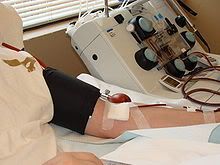
Donating blood is not for everyone. Personally, it doesn't bother me. In fact, one of the goals I wanted to achieve once I turned 18 was to donate blood. The other was to vote. Yeah, I know, I am a geek. I have been donating blood (and voting) off and on since I was 18--being turned down every now and then because I was underweight (How many times you can say that in your life? roflmao), because my iron was too low or I wasn't drinking enough water.
Drinking enough water is important in the donation process. Water helps the tech find your veins easier and it also makes the blood flow faster. Trust me; as much as I don't mind donating blood, I want the tech to find that vein as fast as they can. Needles don't bother me, but I do want a smooth and fast insertion. I'm not into pain, especially my own pain.
When I got the phone call asking if I'd donate platelets, I was a bit nervous. I had not done it before--I tried once before but, again, I wasn't drinking enough water so it would have been too hard to find a decent vein.
Platelet donations are important. Platelets help the body coagulate the blood. That way you won't bleed to death. Some people have a hard time creating platelets, especially those who are going through chemotherapy. Donations help build up their systems to fight the cancer.
I've seen the machines they use to remove platelets when I donated blood. They are intimidating machines with lots of doodads hanging off them. I will admit they scared me because of my ignorance about them.
I was taking the day off from work anyway for a doctor's appointment, so I agreed to donate. The process was going to take about two hours all together. That's way longer than just donating blood, but I learned there is a bit more involved with platelet donation than just donating blood.
With platelet donation, they take blood out of you, and separate it to collect the platelets, and then return the blood back into your body with an anticoagulant called sodium citrate. One of the side effects of the anticoagulant entering into my body was the "metallic ting" taste in my mouth. It was no big deal, they just gave me some Tums antacids and I chewed on them. The tingly taste when away quickly and didn't bother me anymore. I wasn't nauseated or dizzy.
You get to choose a movie to watch during the procedure (I watched Night at the Museum again). I was in the chair for about 90 minutes straight. You have to make sure you go to the bathroom first because once you are hooked up, you can't move. For me, that was the biggest psychological challenge. If you tell me I can't go to the bathroom, then all I want to do is go to the bathroom. But I surprised myself and did fine.

I had a single vein procedure. This means they use one needle/catheter in one arm to extract and return my blood. So it would draw for a certain time, then stop and return for a certain time. I did feel the pressure on my vein when the blood was being pumped back into my body. But after experiencing it a couple of times, I got used to it.
I wasn't the only person in there donating platelets. They had put the call out and many donors were kicking back in the chairs, watching movies and donating. The platelets don't have a long shelf life, so the donations are used within the week. We were helping people right away--our donation wasn't being stored away for a rainy day. It's needed right away. It's an awesome experience to know that what you are doing might save someone's life that same day or week.
I didn't know until they were done that I was a bonus donor. I had enough platelets in my body that my one donation would be able to help three patients or three treatments for one patient.
You can donate faster for platelets than just donating blood. Instead of waiting 56 days to donate blood again, you can donate platelets as quickly as three days later, if so needed. It's better for a person getting the donation to get platelets from the same donor to decrease problems. Some people who went through organ transplants or fighting leukemia might need multiple treatments to help them.
Personally, I might not donate again this week, but I will donate at least once a month. They offer appointments at the South Texas Blood Bank on Saturdays, so I don't have to take time off from work. The recovery time for me was nothing. I just had to make sure I drank liquids afterwards and take it easy for the rest of the day. No exercising (no complaints on that one, lol) and no heavy lifting. I felt fine afterwards.
Call your local blood bank if you are interested in donating platelets. It's a short break from your day that could help save someone's life. Go on, give a call and donate.
In south Texas, check out the South Texas Blood and Tissue Center. You can visit their headquarters in their donor pavilion, located at 6211 IH 10 W., First Park Ten Boulevard in San Antonio. Contact them at (210)731-5555.
No comments:
Post a Comment